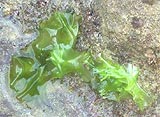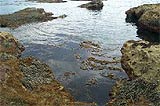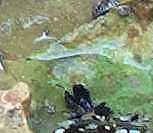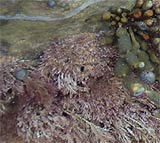|
Rocky Reefs
2. The Physical Environment
Ecology - Producers
Algae growing on the rocks provide food for a range of grazing animals that wander across the rock platform or on the subtidal reefs. These range from microscopic algae on the rock surface, to small to be seen without a microscope, to the larger green, brown and red algae that grow in different parts of the rock platform and below the surface. |

Green algae |
| |
|

Brown algae in a rockpool |
Plankton and other material that is drifting in the water also represent a major food source for animals on reefs and the rocky shore. As the tide and waves carries the water over the rocks many non-moving animals are able to feed by filtering this material from the water directly.
Algae and other dead material that accumulates on rocky reefs also represents an important food source for scavenging animals such as shrimp and crabs. |
| |
|
|
There is a wide range of seaweed species found on rocky reefs on the South West Coast particularly in Victoria and Tasmania. Seaweeds or algae can be divided into three groups based on their colour: green brown and red.
The green seaweeds grow in shallow waters where there is plenty of light. Common green algae include sea lettuce (Ulva sp.), Baitweed (Enteromorpha sp.), and a number of thick green seaweeds including the Sea Apple and Dead Mans Fingers (Codium spp.) |

sea lettuce |
| |
|

Neptune's Necklace |
Brown algae have additional pigments that allow them to survive in deeper water. On many shores the most common intertidal species is Neptune's Necklace (Hormosira banksii), characterised by chains of water filled beads.
At the lower edge of the intertidal area and in deeper water large kelps including Bull kelp (Durvillea potatorum), Leather kelp (Eklonia radiata), Southern giant kelp (Macrocystis angustifolia) and many other species (including Cystophora & Sargassum) form forest like canopies that support a wide range of animals. Individual kelp plants can reach lengths in excess of 10 m, with air bladders supporting the bulk of the plant on the surface |
| |
|
|
Red algae have additional pigment to allow them to live in low light conditions under other seaweeds or in deep water.
Some commonly seen red algae on rocky shores include a large number of crusty pink seaweeds called Coralline algae (Corallina sp.). These plants have a shell around them to allow them to survive between the tides. Many other species survive in deeper water. |

Coralline algae |
|
|
Next - Consumers |
|